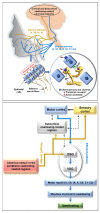Targeting Chemosensory Ion Channels in Peripheral Swallowing-Related Regions for the Management of Oropharyngeal Dysphagia
- PMID: 32867366
- PMCID: PMC7503421
- DOI: 10.3390/ijms21176214
Targeting Chemosensory Ion Channels in Peripheral Swallowing-Related Regions for the Management of Oropharyngeal Dysphagia
Abstract
Oropharyngeal dysphagia, or difficulty in swallowing, is a major health problem that can lead to serious complications, such as pulmonary aspiration, malnutrition, dehydration, and pneumonia. The current clinical management of oropharyngeal dysphagia mainly focuses on compensatory strategies and swallowing exercises/maneuvers; however, studies have suggested their limited effectiveness for recovering swallowing physiology and for promoting neuroplasticity in swallowing-related neuronal networks. Several new and innovative strategies based on neurostimulation in peripheral and cortical swallowing-related regions have been investigated, and appear promising for the management of oropharyngeal dysphagia. The peripheral chemical neurostimulation strategy is one of the innovative strategies, and targets chemosensory ion channels expressed in peripheral swallowing-related regions. A considerable number of animal and human studies, including randomized clinical trials in patients with oropharyngeal dysphagia, have reported improvements in the efficacy, safety, and physiology of swallowing using this strategy. There is also evidence that neuroplasticity is promoted in swallowing-related neuronal networks with this strategy. The targeting of chemosensory ion channels in peripheral swallowing-related regions may therefore be a promising pharmacological treatment strategy for the management of oropharyngeal dysphagia. In this review, we focus on this strategy, including its possible neurophysiological and molecular mechanisms.
Keywords: chemosensory ion channels; molecular mechanisms; neurophysiological mechanisms; oropharyngeal dysphagia; peripheral chemical neurostimulation strategy.
Conflict of interest statement
The authors declare no conflict of interest.
Figures

Similar articles
-
Transient receptor potential channels as an emerging therapeutic target for oropharyngeal dysphagia.Jpn Dent Sci Rev. 2023 Dec;59:421-430. doi: 10.1016/j.jdsr.2023.09.002. Epub 2023 Nov 10. Jpn Dent Sci Rev. 2023. PMID: 38022386 Free PMC article. Review.
-
Effects of capsaicin on swallowing function in stroke patients with dysphagia: A randomized controlled trial.J Stroke Cerebrovasc Dis. 2019 Jun;28(6):1744-1751. doi: 10.1016/j.jstrokecerebrovasdis.2019.02.008. Epub 2019 Apr 5. J Stroke Cerebrovasc Dis. 2019. PMID: 30956054 Clinical Trial.
-
Natural capsaicinoids improve swallow response in older patients with oropharyngeal dysphagia.Gut. 2013 Sep;62(9):1280-7. doi: 10.1136/gutjnl-2011-300753. Epub 2012 Jun 21. Gut. 2013. PMID: 22722616
-
Sensory stimulation to improve swallowing reflex and prevent aspiration pneumonia in elderly dysphagic people.J Pharmacol Sci. 2011;115(2):99-104. doi: 10.1254/jphs.10r05cp. Epub 2011 Jan 18. J Pharmacol Sci. 2011. PMID: 21258172
-
Neurorehabilitation strategies for poststroke oropharyngeal dysphagia: from compensation to the recovery of swallowing function.Ann N Y Acad Sci. 2016 Sep;1380(1):121-138. doi: 10.1111/nyas.13135. Epub 2016 Jul 11. Ann N Y Acad Sci. 2016. PMID: 27398981 Review.
Cited by
-
Molecular and Neural Mechanism of Dysphagia Due to Cancer.Int J Mol Sci. 2021 Jun 29;22(13):7033. doi: 10.3390/ijms22137033. Int J Mol Sci. 2021. PMID: 34210012 Free PMC article. Review.
-
Pharmacological activation of transient receptor potential vanilloid 4 promotes triggering of the swallowing reflex in rats.Front Cell Neurosci. 2023 Feb 22;17:1149793. doi: 10.3389/fncel.2023.1149793. eCollection 2023. Front Cell Neurosci. 2023. PMID: 36909278 Free PMC article.
-
Neuroendocrine cells initiate protective upper airway reflexes.Science. 2024 Apr 19;384(6693):295-301. doi: 10.1126/science.adh5483. Epub 2024 Apr 18. Science. 2024. PMID: 38669574 Free PMC article.
-
Transient receptor potential channels as an emerging therapeutic target for oropharyngeal dysphagia.Jpn Dent Sci Rev. 2023 Dec;59:421-430. doi: 10.1016/j.jdsr.2023.09.002. Epub 2023 Nov 10. Jpn Dent Sci Rev. 2023. PMID: 38022386 Free PMC article. Review.
-
Oropharyngeal swallowing hydrodynamics of thin and mildly thick liquids in an anatomically accurate throat-epiglottis model.Sci Rep. 2024 May 25;14(1):11945. doi: 10.1038/s41598-024-60422-x. Sci Rep. 2024. PMID: 38789468 Free PMC article.
References
-
- Goyal R.K., Mashimo H. Physiology of oral, pharyngeal, and esophageal motility. GI Motil. Online. 2006:1–3. doi: 10.1038/gimo1. - DOI
Publication types
MeSH terms
Substances
Grants and funding
LinkOut - more resources
Full Text Sources
Medical

